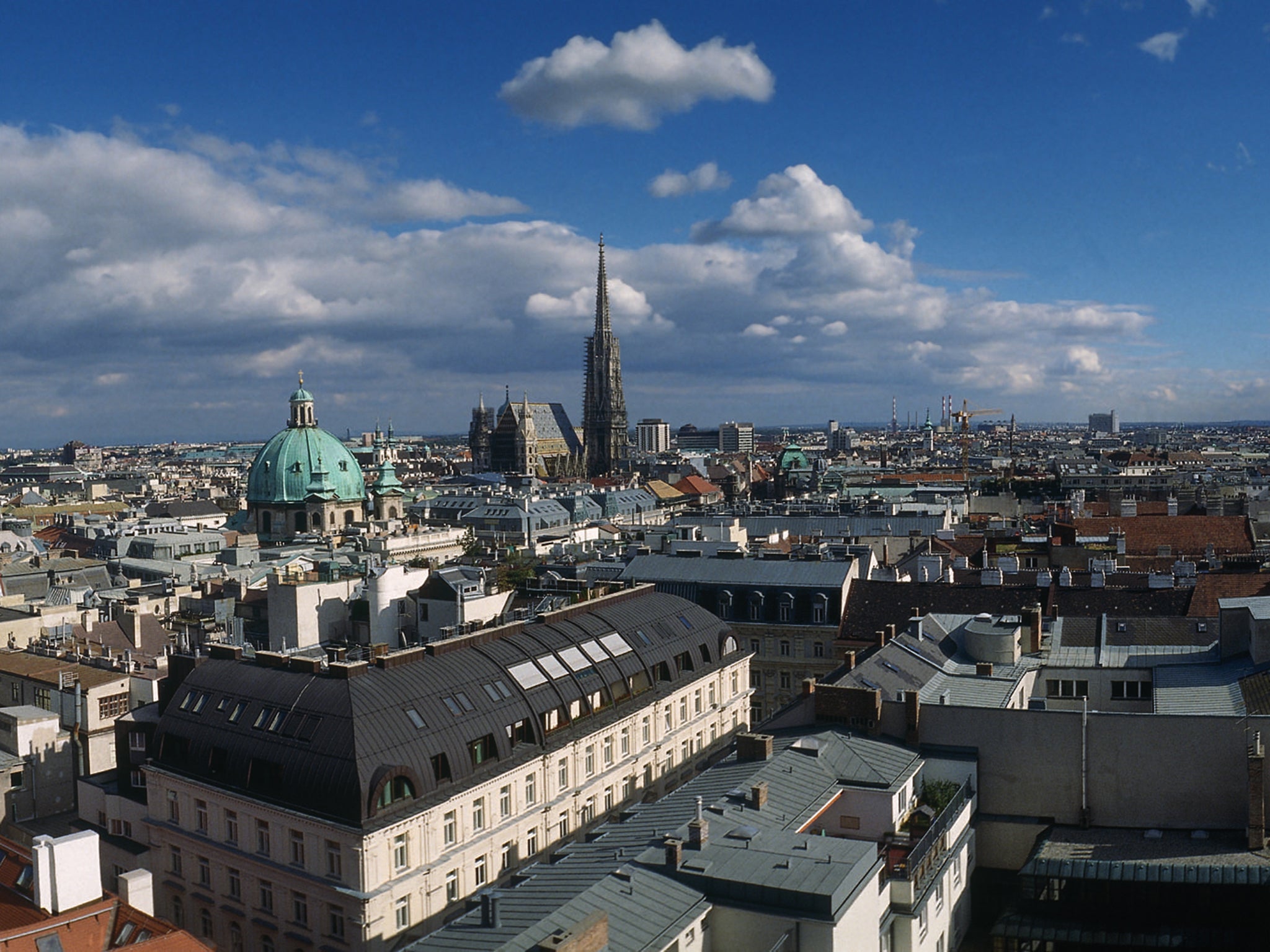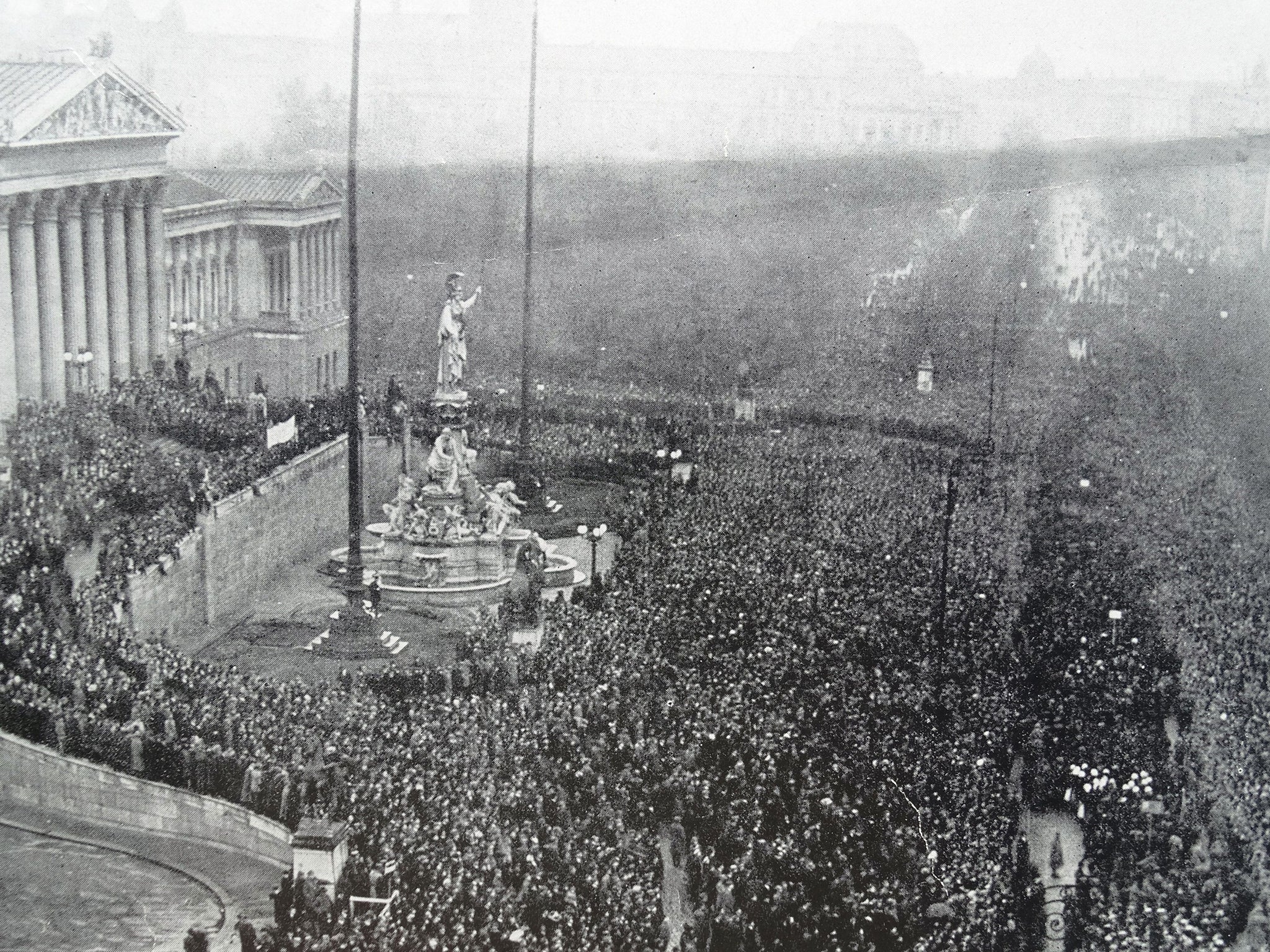A century on from the collapse of the Habsburg empire, could Austria be on the brink once more?
Prosperous, peaceful, progressive and democratic, the Austria of today seems to bear little resemblance to that of 1918. But below the surface, simmering discontent, populist rumblings and nationalist posturing provide unnerving echos of a turbulent past

Your support helps us to tell the story
From reproductive rights to climate change to Big Tech, The Independent is on the ground when the story is developing. Whether it's investigating the financials of Elon Musk's pro-Trump PAC or producing our latest documentary, 'The A Word', which shines a light on the American women fighting for reproductive rights, we know how important it is to parse out the facts from the messaging.
At such a critical moment in US history, we need reporters on the ground. Your donation allows us to keep sending journalists to speak to both sides of the story.
The Independent is trusted by Americans across the entire political spectrum. And unlike many other quality news outlets, we choose not to lock Americans out of our reporting and analysis with paywalls. We believe quality journalism should be available to everyone, paid for by those who can afford it.
Your support makes all the difference.A hundred years ago here in Vienna, a strange thing happened – an empire that had lasted for four centuries suddenly fell apart. Defeated in the First World War, in 1918 Austria’s Habsburg empire was stripped of its foreign territories and reduced to an impotent Germanic rump.
Most countries would rather forget such a national humiliation, but Austria is embracing it. Throughout 2018, the Austrian capital has mounted various lavish exhibitions, marking that fateful year when the country’s ruling dynasty dissolved. As you wander the endless corridors of Vienna’s palatial museums and galleries, you can’t help wondering: could something similar be about to happen here in central Europe, a hundred years later? Is this year of commemoration an unwitting sign of things to come?
For Germany, the Treaty of Versailles meant crippling reparations. For Austria, Germany’s ally in the Great War, above all it meant loss of land. In 1914, the Habsburgs ruled an empire that encompassed not just Austria and Hungary, but Bohemia, Slovakia, Slovenia, Croatia, large parts of Poland and Romania, and even some of Italy. Inevitably, there was some tension between the different language groups in this unwieldy empire, but on the whole most of its subjects seemed to rub along together pretty well.
In 1918, everything changed. Self-determination was the new buzzword, as Austria’s ethnic populations were granted independence. Italy, Romania and Poland all took big bites out of Austria, and the new hybrid nations of Czechoslovakia and Yugoslavia were born. A multinational empire had been replaced by a patchwork of independent states.
When I first came to Vienna, during the Cold War, that nationalist patchwork still prevailed. Stuck in a Cold War cul-de-sac, surrounded on three sides by the iron curtain, Vienna felt like a frontier town, a dead end at the end of a one way street. The fall of the iron curtain (which began when Hungary tore down the fortified fence along its border with Austria) transformed Vienna. Today the city is a crossroads again, a place where east meets west. In its elegant cafes, surrounded by Slovenians, Slovakians, Romanians, Czechs and Croats, you could almost be back in the heyday of the Habsburg empire, drinking coffee with Stefan Zweig or Sigmund Freud.

Whether you think the breakup of the Habsburg empire was a good thing or a bad thing has a lot to do with your ethnicity. For Czechs and Slovaks it was a matter for rejoicing, but these partitions created new minorities and helped to sow the seeds of the Second World War, a conflict that fixed these national boundaries by adopting a ruthless process of ethnic cleansing. The German-speaking minorities in these nations were deported to Austria and Germany, lands many of them had never set eyes upon before.
Thankfully, another European war still feels like a fairly distant prospect, but some of the similarities between 1918 and 2018 are uncanny. The countries that emerged from the ruins of the Habsburg empire are now threatening the fragmentation of the EU. Populist politicians are in power in the EU’s four “Visegrad” countries (Poland, Hungary, the Czech Republic and Slovakia) and now in Slovenia too. None of them want to leave the EU (not yet) but they all want firmer borders and tighter immigration controls. It’s a far cry from the “ever closer union“ which used to be the EU’s mantra.
Critics of the EU like to compare it to the USSR, but the Habsburg empire is a far more meaningful comparison. Like the Habsburg empire, the EU is bureaucratic and inefficient. Like the Habsburg empire, it’s also civilised and benign. Unlike the USSR, it doesn’t prevent its citizens from leaving. Unlike the USSR, it doesn’t need to. It’s a point well worth repeating if you end up in a twitter war with some of those Europhobes who like to refer to the EU as the “EUSSR”: the USSR was full of people trying to get out; the EU’s biggest problem is that it’s being besieged by people trying to get in.
On the whole, the Habsburg empire (like the EU) was a very agreeable place to live in. So why did it collapse so suddenly? Because, like the EU, it tried to impose its rules too rigidly on its diverse citizens. Like the EU, the Habsburg empire was one-size-fits-all, rather than made-to-measure. What suited Austrians and Hungarians, and quite a lot of Czechs and Slovaks, didn’t suit its Balkan peoples (egged on by an expansionist Russia – another similarity with today). A bit more give and take and Austria’s Balkan crisis might have blown over, and Europe would have been spared the horrors of two world wars, the Holocaust, and half a century of Soviet tyranny.
There was an air of Götterdämmerung about Austria’s collapse in 1918. Like the final part of Richard Wagner’s Ring Cycle, this felt like the twilight of the gods. Gustav Klimt, Koloman Moser, Egon Schiele and Otto Wagner all died that year – four of the most creative men in Austria: two of its greatest artists (Klimt and Schiele); its most innovative and versatile designer (Moser) and its finest architect (Otto Wagner, no relation to the composer).
Otto Wagner was in his seventies, but Klimt was only 55 and Moser merely 50. For Austria’s visual arts, this was a tragedy indeed. Of course, most Austrians had more pressing concerns in 1918 than the future of Austrian art and architecture, but it still stands as a potent symbol for a more universal malaise. Old Austria was dying, and with it the old European order, which had endured since the defeat of Napoleon. You can see why Vienna’s season of shows about these artists is called Beauty & The Abyss.
Most tragic of all was the death of Egon Schiele, aged just 28, carried off by Spanish flu (which killed more people than the First World War). Today Schiele is renowned for his emaciated sickly nudes, but as a brilliant new exhibition at Vienna’s Leopold Museum demonstrates, this was merely the first phase of what should have been a long and varied career. Strangely, as the Great War approached its awful climax, and Austria’s annihilation drew near, Schiele’s work became calmer and more optimistic. He was just getting started on this new phase when his life was snatched away.
Germany endured an even more comprehensive Götterdämmerung at the end of the Second World War – its cities destroyed, the country divided, its people shamed into silence by the moral catastrophe of the Shoah. No wonder Germans call 1945 Stunde Null – “hour zero”. Yet this hour zero also marked a break with the past and a new beginning. In 1918, Austria merely entered a kind of twilit interregnum, stumbling from democracy into dictatorship, and eventually, in 1938, into an Anschluss with Hitler’s Germany.

For Austria, the immediate aftermath of the Second World War was similarly inconclusive. Like Germany, the country was jointly occupied by the USA, the USSR, France and Britain – but unlike Germany it was never subjected to such a rigorous process of “denazification”. Rightly or wrongly, Austria was regarded as Nazism’s first victim. Consequently, while the responsibility for Nazism became the moral backbone of the German Bundesrepublik, Austria maintained an uneasy silence about the crimes of the Third Reich. Only belatedly, by a new generation, has that silence been broken.
So what of Austria in 2018? Does it bear any similarities with Austria in 1918? Superficially, none whatsoever. The country is prosperous and peaceful, progressive and democratic. Its perpetual neutrality is guaranteed by its constitution. It’s securely anchored in the EU and the eurozone.
But beneath this balmy surface are signs of simmering discontent. Since the Second World War, Austrian politics has usually shuffled inconsequentially between centre left and centre right, often in series of ineffectual coalitions. Conversely, Austria’s new government is a combustible alliance of centre right and hard right. Under its charismatic new leader, 31-year-old wunderkind Sebastian Kurz, Austria’s centre-right People’s Party has formed a controversial alliance with the hard-right Freedom Party – a party founded by some former Nazis (among others) after the Second World War.
Will the responsibilities of government normalise the Freedom Party? Or will it merely empower them and drive Austria even further to the right? For now the jury is still out, but at the very least their popularity shows large numbers of Austrians are disillusioned with centrist politicians, and the conventional solutions they offer. Twenty-six per cent of Austrians voted for the Freedom Party in last year’s election. Can Kurz win them back?
The contrast with Germany is stark. Germany’s rapidly growing hard-right party, Alternative für Deutschland, remains shut out of national government, even though AfD came third in last year’s elections, just like the Freedom Party in Austria. Will the Freedom Party be neutralised or galvanised by high office? Will it become more centrist or more extreme? The answers to these questions will shape Europe as a whole.
In the meantime, in those Visegrad countries that were Austrian until 1918, nationalism is on the rise, and whenever nationalism rears its head, Europe is in for stormy weather. Is the EU entering its late Habsburg phase? Let’s hope not, for all our sakes, but the parallels are intriguing. On second thoughts, Vienna in 2018 is nothing like Vienna in 1918. It’s a lot more like Vienna in 1914.
William Cook was awarded the Johann Strauss Gold Medal for his reporting from Vienna. For more information about Beauty & The Abyss, visit Viennesemodernism2018.info
Join our commenting forum
Join thought-provoking conversations, follow other Independent readers and see their replies
Comments